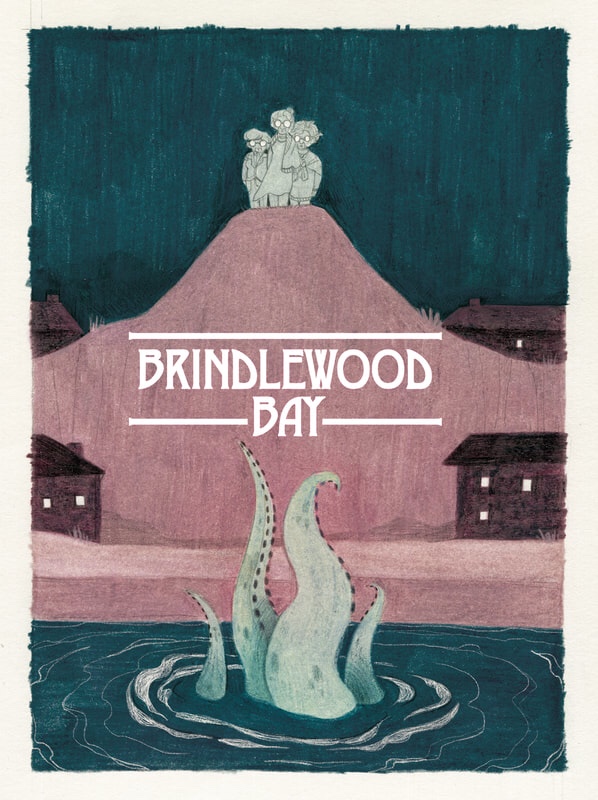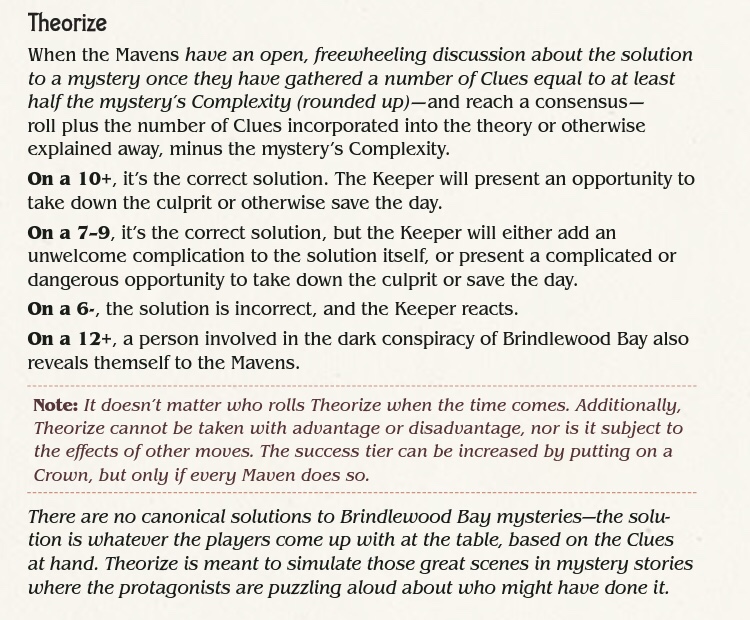I Read Games reviews are me reading games when I have nothing better to do, like read a module or write or play a game. I don’t seriously believe that I can judge a game without playing it, usually a lot, so I don’t take these very seriously. But I can talk about its choices and whether or not it gets me excited about bringing it to the table.
I was supposed to play a game today, but most of the table were sick, so instead I’m going to read Brindlewood Bay, because someone was talking about it on Twitter the other day (or X, I guess? I still have the birdy on mine) and that reminded me I was excited about this innovative murder mystery game back when it kickstarted (although to my knowledge the print copy hasn’t been released yet, as I haven’t received my copy). The pitch for Brindlewood Bay is Murder She Wrote meets Lovecraftian horror, with the mechanical twist that the mystery has no canon solution: The characters come up with one as the clues reveal themselves.

It doesn’t brand itself as a Powered by the Apocalypse game, but shows significant inspiration from that lineage. Most of the basic moves themselves are awkwardly named, giving no indication of their use (“Day”, “Cosy”, “Meddling”). One is pointlessly vague: “imagine what your actions would look like as a move”? I’m not a fan of game design that asks the players to game design on the fly. There’s one unabashedly excellent basic move, a Murder She Wrote reference that’s well named and well written. I’ll come back to the Theorize move later, as it’s a big one. Regardless of the quality of the moves, I appreciate the designer commentary that accompanies them, although I feel they’d be unintelligible without them, which implies the author knows they aren’t their best selves. Overall, I don’t think it demonstrates a solid understanding of the powered by the apocalypse approach, sad on a field already filled with half-assed skins with little to no understanding of how the original functioned. Mechanical twists are clumsy and uninteresting, like three-dice advantage and disadvantage, and Crowns, which are so difficult to parse that I wrote this explanation wrongly the first time.
The layout here is fine. I really like the art all the way through the book. There’s not much else to say; it’s a serviceable book, but to a degree it fits the elderly lady theme. The structure, however, is the real design problem.
The structure of the book is a mess. We have a description of the character sheet (repeating a few rules and foreshadowing others), then goes into the rules for sessions that aren’t the first session (which has its own rules), then custom moves (I’ll come back to these), then two chapters of GM advice, then four additional chapters of GM lore and how to use it, and then a bunch of mysteries, and then how to run your first session. Hire a developmental editor, for your reader’s sake, please. I honestly couldn’t imagine a worse organised book, although I recognise some of the reasoning behind the choices here.
The custom moves are absolute fire, each based on a classic crime solver, granting a maven (PC) a special move. My favourites are Michael Knight, “You have a trusty mode of transportation—an oversized sedan, a motorbike, or an old truck—that has gotten you out of more than one sticky situation.” and Tintin, “Pick this move because talking dog.” These are flavoursome and perfectly on theme. The love for the source material is very clear in this chapter.
From here we’re start 130 pages of explicitly GM only advice. This is a game I’d like to run. I’m curious enough to run it at the absolute least, as I’m very interested in playing investigative games. But oh boy 130 pages of GM guidance is offputting. The back end of the book makes me want to put it straight in the box in the garage where dull games go to die. The contents of these chapters isn’t bad at all, it’s just a huge amount to process. I can’t imagine at whose table this will be the main game of, but I don’t need an advanced gamemastery chapter that spends two pages each on how to respond to specific basic moves.
The next three chapters are instructions on how to run the underlying evil dark god storyline. Two chapters of this are basically a menu, some actually random tables and some not, that you can use to plan your storyline. There is similarity between these sections and the tabular randomised content in Trophy and Trophy Loom, but that similarity is jarring and inconsistent three chapters. Consistency of approach would be better, but regardless these are the worst possible versions of this content. If I want to create my own story, I can write my own story. Restructure this huge amount of writing as three or four different whole versions of the story that I can choose to take whole cloth or modify as I wish, instead of this mess. I’m not here for a setting toolbox. The chapter of pre-made mysteries is exactly what these chapters should be! The chapter of mysteries is great! Interesting well described characters! Clue lists! Scenes! Locations! Structure is always better than vibes, because we can just change your specific writing, but it’s harder to create something fresh and less worth my time to do so.
I just got to the end of the book, and realised that despite specifically looking for it, I never figured out what ‘Putting on a Crown’ was. I had to piece it together by searching the pdf for “crown” until I figured out that the mavens can do these specific things in game to bump their success level up a notch. Either one about your personal life or a more structured one about the evil cult. This is quite poorly explained, and that’s disappointing, as this is a pretty good tension mechanic.
Now, the elephant in the room: No mystery in this game has a set solution. This is precisely the kind of idea that may be clever and may be complete foolishness. The entire solving of the mystery is supposed to be reminiscent of the scene in classic detective stories where the detective presents a long explanation, solving the mystery. It’s tied directly to a move:

In the context of this move, it is further obscured whether this is foolishness or cleverness. I’m leaning towards clever, for the pure reason that the detectives can be wrong and that their likelihood of being right improves the more clues are accounted for. To me, this makes it feel less like “the detectives make up the answer” and more like “the answer reveals itself to the whole table”.
Gauntlet games tend to fall solidly into the “we’re telling a story together” end of the spectrum, and this way of concluding a mystery really leans into that feeling. I can enjoy that kind of gameplay — Fiasco has been a favourite of mine for many years — but there’s something jarring about the structural contrasts in Brindlewood Bay, where it feels like you’re solving a mystery that is pre-existing by solving pre-existing clues, until you make the theorise move and suddenly you’re negotiating a motive and means for murder together.
Anyway, that’s Brindlewood Bay. It’s probably a good game, but it’s buried in bad structure and an obscenely constructed GM section that tries its hardest to drive people away from it. The smoothness and simplicity of art and layout clashes with the jarring content and structure. Honestly, if I hadn’t paid for a print copy, I don’t think I’d bother. But I’ve paid the money, and I like the premise, so I’ll probably run it, resentful all the whole that I’m going to have to wade through 130 pages of guided novel-writing to run a powered by the apocalypse game about elderly detectives.
August 5th, 2023
Idle Cartulary



Leave a comment